Chapter 1: The History of Engineering
"If
I have seen further than others, it is by standing
upon the shoulders of giants."
- Isaac Newton
Why learn the history? New innovations stand on the shoulders of
those who have gone before.
The speed at which things now change indicate
the urgency of understanding the process of innovation.
Just for fun:
Students heading into their first year of college this year...
http://www.beloit.edu/mindset/.
We live in the information age.
Change is expected.
New generations do not do things the way older generations did.
Now:
Make a house frame in a single day
Then:
200 years to build a church.
40 Maps That Will Help You Make Sense of the World
Students heading into their first year of college this year...
http://www.beloit.edu/mindset/.
We live in the information age.
Change is expected.
New generations do not do things the way older generations did.
Now:
Make a house frame in a single day
Then:
200 years to build a church.
Discussion question:
Why were there so few innovations in the early
years?
We have progressed more in the last 200 years, than in the previous 5,000+ years....
For thousands of years, people farmed with crude manual labor, lived their whole life within a small radius, battles were fought with spears and arrows - technology was stagnant for thousands of years...
- Communication & Transportation.
We have progressed more in the last 200 years, than in the previous 5,000+ years....
For thousands of years, people farmed with crude manual labor, lived their whole life within a small radius, battles were fought with spears and arrows - technology was stagnant for thousands of years...
- Communication & Transportation.
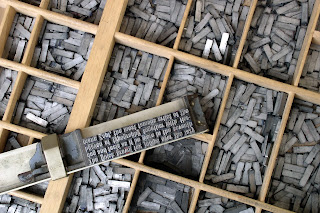 No printing press, no internet, no phones, everyone had to reinvent the
wheel for themselves because they could not learn from anyone except
the people living in the same village as them.
No printing press, no internet, no phones, everyone had to reinvent the
wheel for themselves because they could not learn from anyone except
the people living in the same village as them.Moral of the story?
It's important to learn how to write, present, and otherwise share information. Information is key to engineering.
Prehistoric Culture:
- No math or science
- No written language
- Limited verbal language
- Limited means of transportation
- They didn't go to school
- Spent most of life as hunter / gatherer
- Built using trial and error
- Used intuition
- Craftsmen
Lesson of Prehistoric Man: You can make things without understanding the science behind why it works.... but the more you understand, the better your product will be.
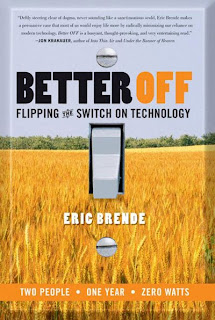 Discussion Question:
Discussion Question:
Are we better off?
Archimedes refused to release information that could be used to make more effective weapons; he knew it would be used for evil... only when his home city was no longer able to hold off Roman attacks did he release his inventions to the military.
- No math or science
- No written language
- Limited verbal language
- Limited means of transportation
- They didn't go to school
- Spent most of life as hunter / gatherer
- Built using trial and error
- Used intuition
- Craftsmen
Lesson of Prehistoric Man: You can make things without understanding the science behind why it works.... but the more you understand, the better your product will be.
 Discussion Question:
Discussion Question:Are we better off?
Archimedes refused to release information that could be used to make more effective weapons; he knew it would be used for evil... only when his home city was no longer able to hold off Roman attacks did he release his inventions to the military.
1.3 Earliest Days
- improved ways to hunt and fish
- methods for providing shelter
- Weapons for power struggles
- religious observances
Everyday life was an engineering project.
Every person was an engineer
Egypt and Mesopotamia
The dawn of specialization.
- Toolmakers concentrated on making tools, Farmers concentrated on their farm, hunters concentrated on hunting. Working cooperatively in larger communities allowed everyone to attain greater skills in areas of specialization.
4000-2000 BC
- copper and bronze tools
- stone tools
- development of the plow
- wheel, sailing boat, methods of writing
Pyramids 2700-2500 B.C.
The great Pyramid
- largest masonry structure ever built
- 756 feet per side, 480 feet tall - dimensions indicate they understood 3.14159
- 2.3 million stone blocks, each weighing between 2.5 tons (5,000 pounds) to 20 tons (40,000 pounds)
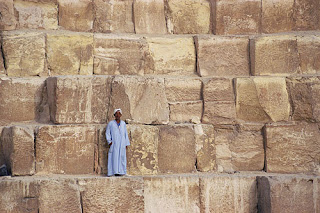 - 58,000,000 tons total.
- 58,000,000 tons total.
To build it, had to - transport large stones long distances
- aligned almost perfectly North South
- create an almost perfect square (only a few inches off)
- symmetrical, precise angles
- Ingeniously design internal chambers that would not cave in under the immense weight of the rocks above it through use of relieving chambers above rooms.
- Precision achieved despite being built on irregular rocky knoll.
- Has survived earthquakes, climate changes, etc. still standing after thousands of years.
- the only one of the 7 wonders of the world still standing.
1.4 Ancient Engineering
Parthenon in Athens : 447-438 B.C.House 40' tall Athena statue Ratios and dimensions indicate an understanding of math.
Roman Aqueduct:
Roman Roads
- 4-6" bed of sand
- large flat stones
- clay cement
- retaining walls
- concrete
- Gravel
- roads were 2 to 5 feet thick
- Romans understood the importance of transportation - roads bound their empire together.
- roads encouraged the free exchange of ideas, joined otherwise isolated communities.
The Great Wall of China: 220 B.C.
Purpose - military - repel Mongolians, protect commerce.
3,080 miles long
Metallurgical and Materials Engineering:

Stone Age -
ended between 4500 BC and 2000 BC with the advent of metalworking.
The dawn of specialization.
- Toolmakers concentrated on making tools, Farmers concentrated on their farm, hunters concentrated on hunting. Working cooperatively in larger communities allowed everyone to attain greater skills in areas of specialization.
4000-2000 BC
- copper and bronze tools
- stone tools
- development of the plow
- wheel, sailing boat, methods of writing
Pyramids 2700-2500 B.C.
The great Pyramid
- largest masonry structure ever built
- 756 feet per side, 480 feet tall - dimensions indicate they understood 3.14159
- 2.3 million stone blocks, each weighing between 2.5 tons (5,000 pounds) to 20 tons (40,000 pounds)
 - 58,000,000 tons total.
- 58,000,000 tons total.To build it, had to - transport large stones long distances
- aligned almost perfectly North South
- create an almost perfect square (only a few inches off)
- symmetrical, precise angles
- Ingeniously design internal chambers that would not cave in under the immense weight of the rocks above it through use of relieving chambers above rooms.
- Precision achieved despite being built on irregular rocky knoll.
- Has survived earthquakes, climate changes, etc. still standing after thousands of years.
- the only one of the 7 wonders of the world still standing.
1.4 Ancient Engineering
Parthenon in Athens : 447-438 B.C.House 40' tall Athena statue Ratios and dimensions indicate an understanding of math.
Roman Aqueduct:
Roman Roads
- 4-6" bed of sand
- large flat stones
- clay cement
- retaining walls
- concrete
- Gravel
- roads were 2 to 5 feet thick
- Romans understood the importance of transportation - roads bound their empire together.
- roads encouraged the free exchange of ideas, joined otherwise isolated communities.
The Great Wall of China: 220 B.C.
Purpose - military - repel Mongolians, protect commerce.
3,080 miles long
Metallurgical and Materials Engineering:

Stone Age -
ended between 4500 BC and 2000 BC with the advent of metalworking.
Bronze Age -
The use of copper and it's alloy bronze (Copper + Tin)
Copper melts at 1,085°C
Tin - melts at 231.9°C
Iron Age -
Iron melts at 1,538°C
Harder
to melt - harder to make, plus you have to worry about impurities
introduced in the heating process. (Impurities generally make iron
brittle and worthless)
The
stronger the material a society had, the more it could build, the more
powerful the military (long swords vs. short swords) the more powerful
the society.
Engineering is dependent on the strength of the materials it has to work with.
Engineering is dependent on the strength of the materials it has to work with.
1200 B.C.
- better iron, better swords
- Siege towers
- Greeks invent manufacturing
- Archimedes introduces math
- high quality concrete used for roads, bridges, and aqueducts in Rome.
AD 1-1000
- Chinese develop math

- Cotton and silk manufactured
AD 1000-1400
- silk and glass industries grow
- Leonardo Fibonacci (1170-1240) invents algebra
AD 1400-1700
- Metallurgy! De re Metallica by Georgius Agricola
- First timed bomb - Giambelli
- The first water closet (toilet) England
- Galileo makes and looks through telescopes
- Windmills - Leeghwater
- Pendulum-driven clock - Huygens
- Watch spring - Hooke
- Royal Society of England - first science community
- Isaac Newton makes first reflecting telescope
- First steam pump - Savery
- Agriculture, mining, textile, and glass-making industries expanded
- Scientific Method originates
- Humanities separated from science
- Boyles' Law - gas pressure varies inverse with volume
- Calculating machine - Leibniz
AD 1700-1800
1760 Industrial Revolution!
- James watt makes first rotary engine
- 1st Civil Engineering School
- First submarine
- pudding furnace, and crucibles for making iron
1800-1825
- Automation
- First railroad locomotive
- Fourier - complex wave = sum of simple waves
- Fulton steamboat service
- Chemical symbols developed
- Wire telegraph
-photography
- electromagnetism
-thermocouple
- Aluminum
- Electric current in motors - Andre Ampere
- Thermodynamics - Carnot
1825-1875
Vulcanized rubber by Charles Goodyear
-iron hulled steam engine
- James watt makes first rotary engine
- 1st Civil Engineering School
- First submarine
- pudding furnace, and crucibles for making iron
1800-1825
- Automation
- First railroad locomotive
- Fourier - complex wave = sum of simple waves
- Fulton steamboat service
- Chemical symbols developed
- Wire telegraph
-photography
- electromagnetism
-thermocouple
- Aluminum
- Electric current in motors - Andre Ampere
- Thermodynamics - Carnot
1825-1875
Vulcanized rubber by Charles Goodyear
-iron hulled steam engine
- rotary printing press
- reinforced concrete
- Singer invents sewing machine
- symbolic logic - Boole
- celluloid - synthetic plastic - Alexander Parkes
- Mass produced steel - Bessemer
- First oil well drilled in Pennsylvania
Typewriter perfected
Challenge Ocean Expedition
1875-1900
-Phonograph - Thomas Edison
- Light bulb - Edison
Gas engine - Daimler
Automobile - Karl Benz
1900-1925
- My grandparents were born
The "golden" generation has lived long enough to see:
- wright brothers complete first flight
Detroit center of auto industry
stainless steel in Germany
Tractors
First commercial airplane between London and Paris
Diesel locomotives
1925-1950
- Sound recordings
- Baird invents TV
- VW beetle
- First nuclear bomb
Transistor
1950-1975
Computers
first artificial satellite
Lasers
integrated circuits
first manned moon landing
1975-1990
Supersonic transport from US to Europe
Cosmonauts
Columbia Space Shuttle
First artificial human heart
1990-Today
Robots walk on Mars
Computer speed increased
Chunnel from England to France
Kuala Lumpur
Thunderhorse...
What will you see in your lifetime?
Where do you fit in with all of this?It is estimated that to produce just one pound (0.45 kg) of honey, the average hive of 20,000 to 60,000 bees must collectively visit millions of flowers and travel the equivalent of two times around the world. Over its short lifetime of just a few weeks to four months, a single honeybee’s contribution of honey to its hive is a mere one-twelfth of one teaspoon.
The "golden" generation has lived long enough to see:
- wright brothers complete first flight
Detroit center of auto industry
stainless steel in Germany
Tractors
First commercial airplane between London and Paris
Diesel locomotives
1925-1950
- Sound recordings
- Baird invents TV
- VW beetle
- First nuclear bomb
Transistor
1950-1975
first artificial satellite
Lasers
integrated circuits
first manned moon landing
1975-1990
Supersonic transport from US to Europe
Cosmonauts
Columbia Space Shuttle
First artificial human heart
1990-Today
Robots walk on Mars
Computer speed increased
Chunnel from England to France
Kuala Lumpur
Thunderhorse...
Large Hadron Loop finds "God" particle?
What will you see in your lifetime?
Where do you fit in with all of this?It is estimated that to produce just one pound (0.45 kg) of honey, the average hive of 20,000 to 60,000 bees must collectively visit millions of flowers and travel the equivalent of two times around the world. Over its short lifetime of just a few weeks to four months, a single honeybee’s contribution of honey to its hive is a mere one-twelfth of one teaspoon.
Though seemingly insignificant when compared to the total, each bee’s
one-twelfth of a teaspoon of honey is vital to the life of the hive.
It's not about the single bee - it's about the hive. Be part of something bigger than yourself!
It's not about the single bee - it's about the hive. Be part of something bigger than yourself!
ENGR1201: Group Homework assignment #1:
Engineering Product Paper & Presentation.
Due: 9-2-2014
Due: 9-2-2014
For this group assignment, choose something that was created by an engineer, and create a 4-5 page long report and presentation on it. Choose something sufficiently complex that requires advanced engineering skills to build (in other words, don’t choose something as simple as “a table” to do your report on), but specific enough that a general understanding is possible in a short report (ie, instead of choosing something like an entire airplane, choose only one part of the airplane, like a jet engine, to do your report on.) Use your own words, and reference internet sites (or books) that you get your information from.
Heading: should include class name, date, project title, and the names of all the group members.
Section 1: (10 points)
Find, and print out a diagram of this product using the image search tools on google. Briefly explain what it is, what it does, and how it operates.
Section 2: (10 points)
Explain the process used to make this product including what company makes it, what raw materials were used, how they were formed, and how different parts of the product were assembled.
Section 3: (10 points)
Discuss different models of this product, and how the design has evolved through time.
Section 4: (10 points)
Make a list of several different engineering disciplines that were involved in making the product, and explain what each type of engineer contributed. Include a short biography on one prominent engineer who significantly contributed to the existence of your chosen product.
Presentation: (40 points)
Print out one or two pages per section that summarize your findings. You may use the class document camera, but you should not just read straight from your slide.
Keep it brief! 2 minutes per section, skip the details, and present only the general idea of the thing. Be prepared to answer a few simple questions as a group at the end of your presentation.
Format: (20 points)
**********************************************************************************
Example Product: 4-stroke internal combustion engine.
Section 1:. Diagram of a 4-stroke internal combustion engine:
Engine Block:
(1) ** Study these diagrams, watch instructional youtube videos, and be prepared to explain the operation during the class presentation.
Section 2: Production of internal engine.
Raw materials.
Mark Wan from the AutoZon Technical school reports that most engines are now made out of lightweight Aluminum that is coated with either cast iron or Nickel-silicon carbide to reduce friction between the parts.(2) The materials that combustion engines are made from has changed from cast iron to Aluminum alloys in order to reduce the weight of the engine and produce higher energy efficiency.
Process.
The engine block is created by “sand casting” or melting the desired aluminum alloy, and then pouring the molten metal into a sand mold. After the metal hardens, the sand is removed, and the engine block is machined into it’s final form. (3)
The pistons, crankshaft, and other rods are created through a forging and forming process where metal is heated and forced through a die. The forging process increases the strength of the metal by introducing atomic packing defects which prevent slip planes from propagating in the microstructure of the metal. (4, 5)
Mark Wan from the AutoZon Technical school reports that most engines are now made out of lightweight Aluminum that is coated with either cast iron or Nickel-silicon carbide to reduce friction between the parts.(2) The materials that combustion engines are made from has changed from cast iron to Aluminum alloys in order to reduce the weight of the engine and produce higher energy efficiency.
Process.
The engine block is created by “sand casting” or melting the desired aluminum alloy, and then pouring the molten metal into a sand mold. After the metal hardens, the sand is removed, and the engine block is machined into it’s final form. (3)
The pistons, crankshaft, and other rods are created through a forging and forming process where metal is heated and forced through a die. The forging process increases the strength of the metal by introducing atomic packing defects which prevent slip planes from propagating in the microstructure of the metal. (4, 5)
Assembly:
Parts are assembled through a combination of machines and manual labor. (6)
Parts are assembled through a combination of machines and manual labor. (6)
Example companies that produce combustion engines:
GM, Ford – United States
GM, Ford – United States
VW, BMW – Germany
Toyota, Nissan, Honda – Japan
Hyundai – South Korea
Section 3: Brief history of the internal combustion engine.Read through resources such as this:
http://en.wikipedia.org/wiki/History_of_the_internal_combustion_engine
Section 3: Brief history of the internal combustion engine.Read through resources such as this:
http://en.wikipedia.org/wiki/History_of_the_internal_combustion_engine
Choose and highlight what you believe to be the most important developments of your product.
Section 4: Engineering Disciplines needed in creating an internal combustion engine:
- Chemical Engineer – Refines the fuel used in the engine.
- Mining Engineer – blasts away rocks to reveal ore veins, and mine the raw materials for the parts.
Section 4: Engineering Disciplines needed in creating an internal combustion engine:
- Chemical Engineer – Refines the fuel used in the engine.
- Mining Engineer – blasts away rocks to reveal ore veins, and mine the raw materials for the parts.
- Metallurgical and Materials Engineer – Creates the best material (lightweight, strong, corrosion resistant, performs under high-temperatures and pressures, cost effective) from the ore produced by the mining engineer.
- Mechanical Engineer – Designs engine using applied mechanics and thermodynamics calculations.
Give a short biography of one of the original engineers who first created or significantly improved the product.
References:
*** check out the "How It's Made" youtube videos - these are a great reference! Just do a youtube search with "How it is made ____________" fill in the blank with your product. Wiki is fine, materials from other schools are fine, materials from companies are fine - use a variety of different reference sources in your report.
1.) Diagrams:
Engine Block: http://www.likecars.com/wp-content/uploads/2011/09/Basic-4-Cylinder-engine-block.gif
- Mechanical Engineer – Designs engine using applied mechanics and thermodynamics calculations.
Give a short biography of one of the original engineers who first created or significantly improved the product.
References:
*** check out the "How It's Made" youtube videos - these are a great reference! Just do a youtube search with "How it is made ____________" fill in the blank with your product. Wiki is fine, materials from other schools are fine, materials from companies are fine - use a variety of different reference sources in your report.
1.) Diagrams:
Engine Block: http://www.likecars.com/wp-content/uploads/2011/09/Basic-4-Cylinder-engine-block.gif
Four-stroke Cycle: http://media.web.britannica.com/eb-media/72/93572-034-26C16785.jpg
2.) Advanced Engine Material, by Mark Wan, AutoZine Technical School © 1998-2000 http://www.autozine.org/technical_school/engine/tech_engine_6.htm
3.) How Is an Engine Block Made? By Nancy Lovering
http://www.ehow.com/facts_7606610_engine-block-made.html
6.) How It's Made Car Engines
http://www.youtube.com/watch?v=lsDoT2oVQUQ
~~~~~~~~~~~~~~~~~~~~~~~~~~~~~~~~~~~~~~~~~~~~~
For your presentation, watch TED talk:
Check out some of the "How it's Made" youtubes.
Check out some of the "Modern Marvels" youtubes. (The "Engineering Disasters" series on Modern Marvels are particularly entertaining.)
~~~~~~~~~~~~~~~~~~~~~~~~~~~~~~~~~~~~~~~~~~~
From "Writing as an Engineer" by David Beer and David McMurrey
a.) When they bought the machine they weren’t aware of it’s shortcoming.
c.) Wordy
Accuracy


Use Lists
Lists are often the most efficient way to communicate information.
List material from most important to least important
3 types of lists:
Directness:
Avoid suspense.
Put the most important information first.
example: Indirect: After a long and difficult development cycle due to factory renovation, the infrared controller will be ready for production in the very near future.
Direct: The infrared controller will be ready for production March 4. Its development cycle was slowed by the factory renovation.
Avoid wordiness
Avoid unnecessarily pompous or ostentatious & showy words. The point of technical documents is to convey information, not to make yourself look smart.
keep it simple and straightforward.
Remember, often your readers have English as their second language.
pompous - straightforward
Turning verbs into nouns:
Write in an active voice (rather than passive) by using verbs instead of nouns.
wordy – clear
Report
References
Should be numbered at the end of the report, and referred to in the text by their number.
Presentation Checklist:
~~~~~~~~~~~~~~~~~~~~~~~~~~~~~~~~~
Make sure you know how to format a technical paper before your next report!
Learn how to add numbered footnotes - (google it if you don't know how)
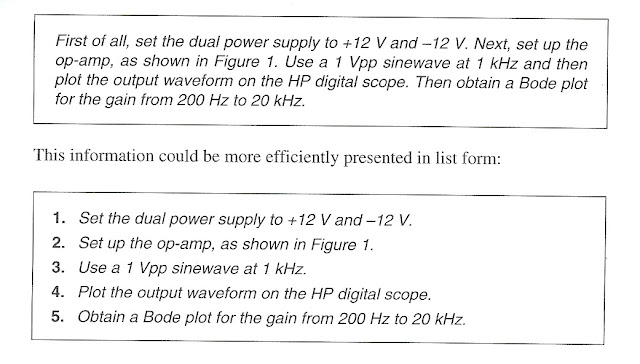
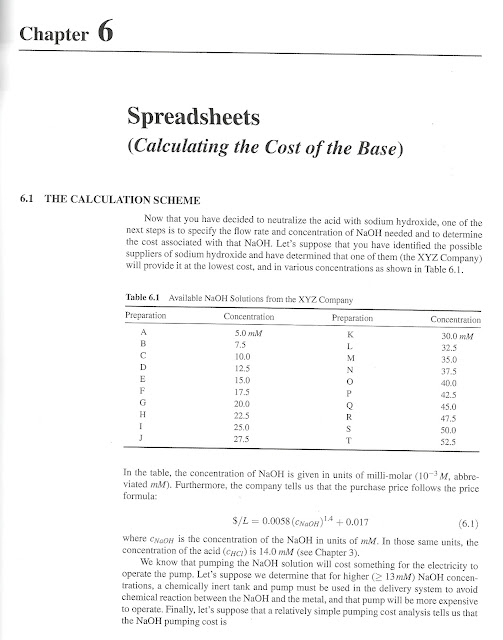
Use the LSC writing center!!
~~~~~~~~~~~~~~~~~~~~~~~~~~~~~~~~~~~~~~~~~~~~~~~
Start brainstorming ideas on what you want to do for
your big engineering project.
Consider choosing a
civic engagement & community service
project:
Check out: http://www.volunteermatch.org/
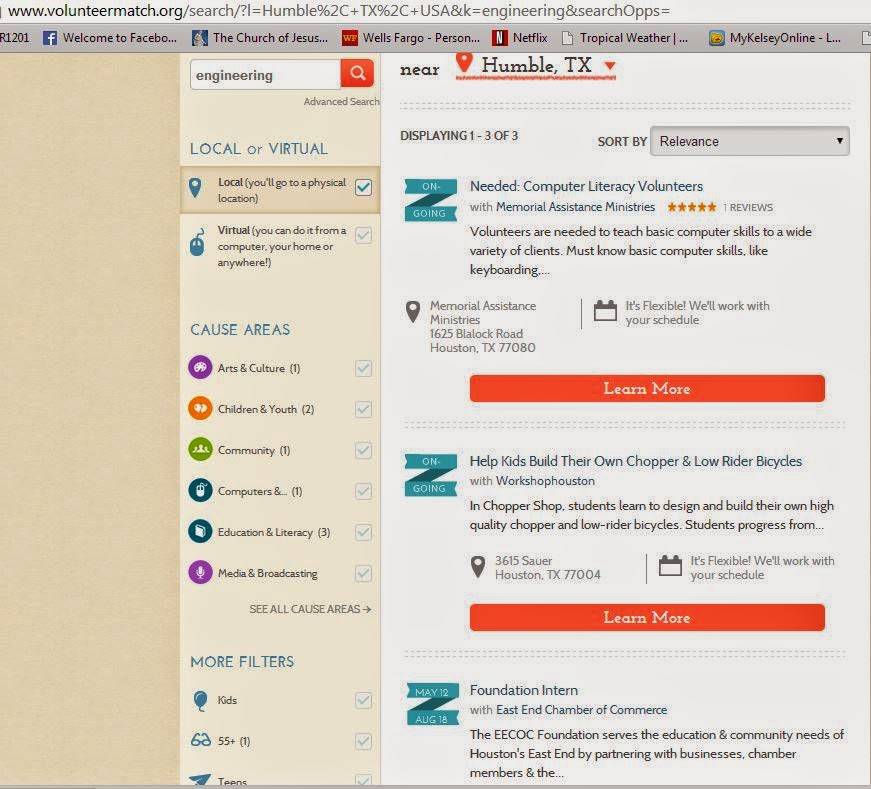
or idealist.org for community service needs, or bring your own ideas.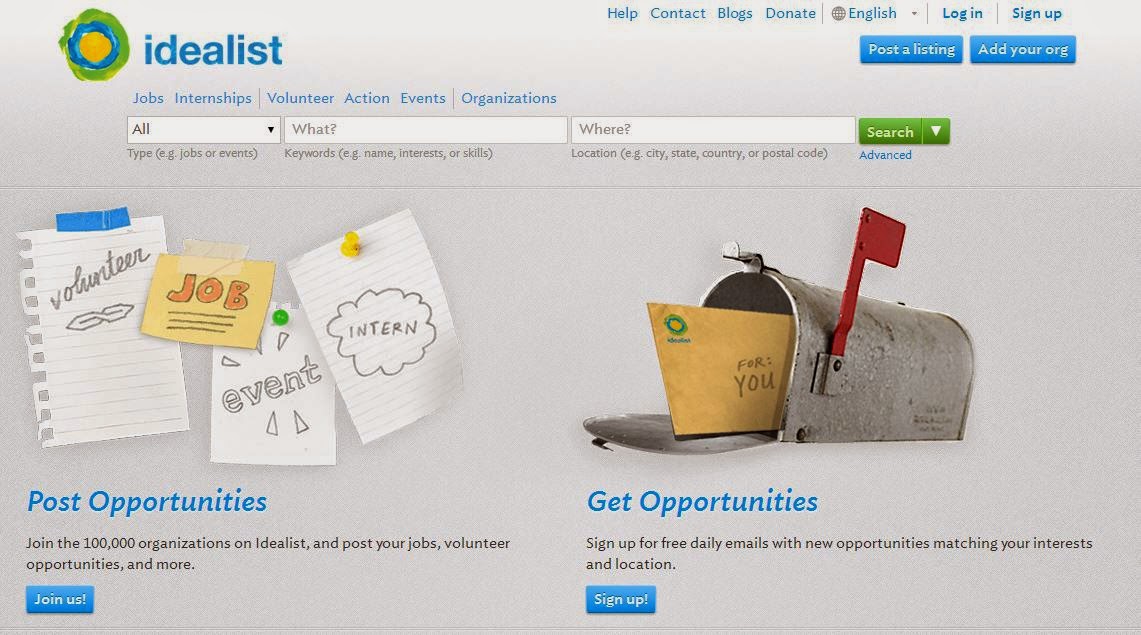
http://college-sustainability.org/blog/
Examples:
Misc:
If you choose to do a Civic Engagement project, you can submit your project proposal to LSC's Center for Civic Engagement.
David Burre would also love to get a group to work fixing up our community garden and wetlands area site (over by the tennis courts at LSC-KW)
http://www.youtube.com/watch?v=lsDoT2oVQUQ
~~~~~~~~~~~~~~~~~~~~~~~~~~~~~~~~~~~~~~~~~~~~~
For your presentation, watch TED talk:
Check out some of the "How it's Made" youtubes.
Check out some of the "Modern Marvels" youtubes. (The "Engineering Disasters" series on Modern Marvels are particularly entertaining.)
From "Writing as an Engineer" by David Beer and David McMurrey
a.) When they bought the machine they weren’t aware of it’s shortcoming.
b.) There was not a sufficient enough number of samples to validate the data.
c.) Our intention is to implement the verification of the reliability of the system in the near future.
a.)
The possessive form of it = its
it's = it is
it's = it is
Example:
It's raining today. (It is raining today)
The dog wagged its tail.
b.)
redundant and wordy:
There weren’t enough samples to validate the data.
c.) Wordy
We want to verify the system’s reliability soon.
Focus on:
- Why you are writing.
- Why you are writing.
- to inform, request, instruct, propose, recommend, persuade, record?
- Who are your readers?
- Fellow engineers from your field?
- Engineers from a different field?
- Managers? Marketing?
- Mixed audience?
Are you communicating technical information on a level your audience can use?
Are you using appropriate vocabulary, examples, definitions, and depth of detail?
Satisfy Document Specifications
Satisfy Document Specifications
- Adhere to suggested length.
- Format spec’s: headings, spacing, margin widths, font
- Format spec’s: headings, spacing, margin widths, font
Get to the Point
- Put important info first.
- Intro - briefly state key points, complaints, requests, and conclusions.
- Do not include details until the body of the text.
Accuracy
- Accurate references
- Accurate directions and instructions
- clearly state the conditions your data is applicable to.
- Do not state opinions as facts.
Logical Presentation and organization:
- Numbered sections and subsections with titles.
- Organize in levels of detail and importance
- main subject first
- fill in the details later
- First level headings should be in large font
- separate headings from text by one line
- indent minor headings


Use Lists
Lists are often the most efficient way to communicate information.
List material from most important to least important
3 types of lists:
- numbered (or lettered) for procedures, or prioritized lists
- checklists – for things you need to do
- bullet lists – items in list occur in no specific order
Be Clear & to the point:
Ambiguity – comes from the Latin word meaning to be undecided, causes readers to see more than one meaning in your writing without knowing which is correct.
Avoid words like “they” and “it” to be specific and avoid ambiguity.
Ex:
Ambiguous: Before accepting materials from the new subcontractors, we should make sure they meet our requirements.
Who are “they”? the materials? Or the contractors? or both?
Clear: We should make sure the materials from the new subcontractors meet our requirements before we accept them.
Ambiguous: The microprocessor interfaced directly with the 7055 RAM chip. It runs at 5 MHz. (What does “it” refer to?)
Clear: The microprocessor interfaced directly with the 7055 RAM chip. The 7055 runs at 5 MHz.
Vague – contains no useful information.
Example:
“Take a few of these pills every so often.” How many pills? How often?
Vague: The Robotics group is several weeks behind schedule.
Useful: The Robotics group is six weeks behind schedule.
Vague: The CF553 runs faster than the RG562 but is much more expensive.
Avoid words like “they” and “it” to be specific and avoid ambiguity.
Ex:
Ambiguous: Before accepting materials from the new subcontractors, we should make sure they meet our requirements.
Who are “they”? the materials? Or the contractors? or both?
Clear: We should make sure the materials from the new subcontractors meet our requirements before we accept them.
Ambiguous: The microprocessor interfaced directly with the 7055 RAM chip. It runs at 5 MHz. (What does “it” refer to?)
Clear: The microprocessor interfaced directly with the 7055 RAM chip. The 7055 runs at 5 MHz.
Vague – contains no useful information.
Example:
“Take a few of these pills every so often.” How many pills? How often?
Vague: The Robotics group is several weeks behind schedule.
Useful: The Robotics group is six weeks behind schedule.
Vague: The CF553 runs faster than the RG562 but is much more expensive.
Useful: The CF553 runs 84% faster than the RG562 but costs $4,320 - $2,840 more than the CF553.
Coherence – comes from the word “cohere” or stick together.
Clear transitions – use words like “because”, “this shows”, “in addition”, “thus” to link sentences to one another.
Coherence – comes from the word “cohere” or stick together.
Clear transitions – use words like “because”, “this shows”, “in addition”, “thus” to link sentences to one another.
Use a clear subject for each paragraph
Everything should support the subject of report
Directness:
Avoid suspense.
Put the most important information first.
example: Indirect: After a long and difficult development cycle due to factory renovation, the infrared controller will be ready for production in the very near future.
Direct: The infrared controller will be ready for production March 4. Its development cycle was slowed by the factory renovation.
Avoid wordiness
Avoid unnecessarily pompous or ostentatious & showy words. The point of technical documents is to convey information, not to make yourself look smart.
keep it simple and straightforward.
Remember, often your readers have English as their second language.
pompous - straightforward
Commence – start
Compel – force
Comprises – is
Employ – use
Endeavor – try
Fabricate – make
Finalize – end
Initiate – begin
Optimal – best
Prioritize – rank
Proceed – go
Wordy: I regret to say that at this point in time I basically do not have access to that specific information…
Clear: “I don’t know.”
Wordy – efficient
A large number of – many
At this point in time – now
Come in contact with – contact
Exhibits the ability to – can
In the event of – if
In some cases – sometimes
In the majority of instances – usually
Redundancy
using multiple words to say the same thing
Redundant – clear
using multiple words to say the same thing
Redundant – clear
Alternative choices – alternatives
Actual experience – experience
Completely eliminate – eliminate
Connected together – connected
Collaborate together – collaborate
Very best – best
Component part – just say either “component” or “part”not both
Turning verbs into nouns:
Write in an active voice (rather than passive) by using verbs instead of nouns.
wordy – clear
An analysis of the data – analyze
An investigation of xyz – xyz was investigated.
made a selection – select
made a selection – select
Procurement of services can be accomplished by – services can be procured by
Paragraph Length:
Avoid walls of words
rule of thumb – keep paragraphs to under 12 lines
Most paragraphs will be much shorter. (one liners are just fine)
Formatting
Avoid walls of words
rule of thumb – keep paragraphs to under 12 lines
Most paragraphs will be much shorter. (one liners are just fine)
Formatting
Margins – Use large margins to prevent pages looking too busy
Typeface – 10 to 12 point, Times New Roman, Arial
Use ample “white Space” around figures, headings, paragraphs, equations, & lists
Manage your time
Create and use a schedule
Give yourself time to edit
Team: divide and conquer, assign different sections to different people, but then have one person organize, and re-write it to create a smoothly flowing document (rather than a patchwork quilt of different writing styles)
Graphics & Charts –
use numbered figure captions,
refer to the figure in the text by the number.
use numbered figure captions,
refer to the figure in the text by the number.
Tables
include a table heading. Heading go above tables (figure captions go below figures)
include a table heading. Heading go above tables (figure captions go below figures)
References
Should be numbered at the end of the report, and referred to in the text by their number.
Presentation Checklist:
Make sure you know how to format a technical paper before your next report!
Learn how to add numbered footnotes - (google it if you don't know how)
- Use Headings - bold, numbered, underlined
- Use bullet lists and numbered procedures instead of long paragraphs.

-
Use figure captions. Refer to figures in the text.

- If different people write different sections, make sure when you put it all together it looks like one single report written by one single person.
- Don't plagiarize!
- Warning - I do random google checks on what you have written. Cite your references, use small quotes if you need to, but most of the report should be in your own words.
- Pay attention to simple grammar and spelling!
Eye halve a spelling chequer
It came with my pea sea
It plainly marques four my revue
Miss steaks eye kin knot sea.
It came with my pea sea
It plainly marques four my revue
Miss steaks eye kin knot sea.
- Read what you have written out loud
- if it sounds strange when you hear it, then fix it.
- Read through the work of your team.
- Pay them $0.25 for every mistake they find in your work.
- Presentations
- Practice with one another
- practice in an empty room
- videotape yourself, watch yourself, and fix what you see.
Pay attention to people who impress you, - copy their techniques.
Use the LSC writing center!!
~~~~~~~~~~~~~~~~~~~~~~~~~~~~~~~~~~~~~~~~~~~~~~~
Start brainstorming ideas on what you want to do for
your big engineering project.

Consider choosing a
civic engagement & community service

Check out: http://www.volunteermatch.org/


http://college-sustainability.org/blog/
- David Burre: 281-312-1788 or David.L.Burre@LoneStar.edu
Examples:
- Humanitarian projects: Talk with local shelters, nursing homes, low income schools, or police to find needs in the area, then build something to fill that need.
- Environmental project: create a device to conserve water or electricity. Create an innovate way to use trash, or otherwise promote recycling. Create something for local open space areas, such as design environmentally friendly camping sites, or build something to prevent trail erosion.
Misc:
- Create a cool bike rack that promotes community exercise.
- Refurbish old bicycles for disadvantaged children.
- Make a local park more handicapped accessible
- Design a toy or activity that promotes science, technology, engineering, and math at a local school.
- Come up with a plan to improve the parking at LSC.
- Find a cure for cancer... :)
If you choose to do a Civic Engagement project, you can submit your project proposal to LSC's Center for Civic Engagement.
David Burre would also love to get a group to work fixing up our community garden and wetlands area site (over by the tennis courts at LSC-KW)











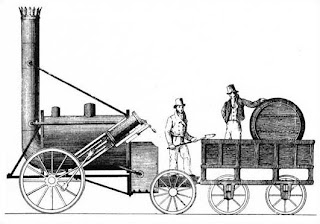










































No comments:
Post a Comment